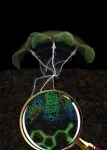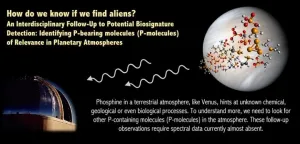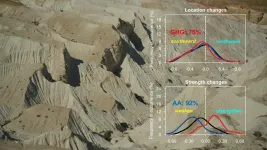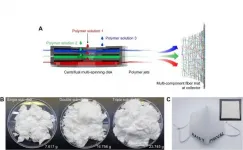(Press-News.org) A team of scientists at the Max Planck Institute for Developmental Biology in Tübingen and the University of Bayreuth have created a novel tool that provides a real-time visualization of the growth-regulating hormone auxin in living plant cells. This new biosensor enables them to observe spatial and temporal redistribution dynamics of the plant hormone, for example in conjunction with changing environmental conditions.
Auxin plays a central role in plant life. The hormone regulates various processes, from embryonic development to the formation of roots and the directional growth in response to light and gravity. Auxin binds to specific receptors in the nucleus of a cell, leading to an activation of signaling cascades that coordinate the plant's response to external stimuli.
Although the molecular action of auxin is well understood mechanistically, it has not been feasible so far to directly observe auxin in individual cells. Instead it was only possible to determine the overall response to, and the general presence of auxin. With the new biosensor, it is now possible to visualize auxin directly in individual plant cells. This way, the rapid and dynamic redistribution of auxin, e.g. upon changing the directional root growth, could be viewed for the first time, almost 100 years after the physiological effects of auxin in plants were first described.
The development of this biosensor, in short AuxSen, is the result of an interdisciplinary collaboration between two teams that built strong synergies in plant biology and protein biochemistry. The goal was easily phrased: Plants should produce a protein that glows when auxin is present, allowing the team to visualize auxin distribution with an optical method. However, the implementation was a bit more complex.
The researchers chose a protein from the bacterium E. coli that binds specifically to the amino acid tryptophan and rather poorly to the chemically related auxin. This protein was coupled to two other proteins that fluoresce when excited with light of a specific wavelength. When these two fluorescent proteins come close to each other, for example due to binding another molecule, the excitation energy of one is transferred to the other protein, and a so-called fluorescence resonance energy transfer (FRET) occurs.
AuxSen combines sensitivity with high specificity of auxin binding
The goal of the engineering process was that this FRET effect should only occur when AuxSen is bound to auxin. For this purpose, the starting protein had to be substantially altered in order to bind strongly to auxin but no longer to tryptophan. Biochemistry became crucial in this experimental phase. Crystal structures of the protein complex with tryptophan or auxin were generated, and the team was able to derive predictions about the effects of amino acid exchanges on the binding to auxin. "For us, it was amazing to see that tryptophan and auxin, two closely related molecules, are oriented very differently in the binding pocket," said co-first author Andre C. Stiel. "This made it easier to improve binding to auxin at the expense of tryptophan." In total, about 2,000 variants were generated in an iterative process and these were tested for their specific binding to auxin, finally leading to AuxSen.
Transferring the AuxSen biosensor from the test tube to transgenic plants posed another challenge of finding the right conditions for AuxSen expression. There was a dilemma. On the one hand, a protein with a high binding affinity to auxin was needed in order to detect auxin with high sensitivity, and this protein should be present in sufficient quantity in all cells; on the other hand, the researchers worried about a disruption of normal auxin activity and that plants might suffer. After some testing, a compromise was found. AuxSen is ubiquitously and strongly expressed, but only after induction with a chemical agent and then for a relatively short time, so that the plants would not be harmed.
New and surprising findings on the redistribution dynamics of auxin in plants
What are the key findings? One unexpected finding is the rapid uptake of auxin into the cells, reflecting their ability to respond fast to changing conditions - after addition of auxin, the team observed a maximum response of AuxSen in the cell nucleus within one to two minutes. Auxin export from the cell appears to be slower, taking about ten minutes for the AuxSen signal to disappear. This difference between fast uptake and slower export might facilitate the directional transport of auxin, for example towards the root tip.
Of particular interest was the rapid auxin redistribution after rotating the plant such that the root tip pointed no longer downward but diagonally upward. Just after one minute, auxin accumulated on the new bottom side of the root tip, and after turning back the root, the former distribution of auxin was restored. "This completely amazed us," commented co-first authors Ole Herud-Sikimic and Martina Kolb. This rapid and reversible response had not been expected. Nor had it been possible to measure this.
The publication of AuxSen is first and foremost a technological breakthrough that has enormous application potential. The conclusion of the two senior authors Birte Höcker from the University of Bayreuth and Gerd Jürgens from the Max Planck Institute for Developmental Biology: "We have shown that both increases and decreases of auxin concentration can be visualized in tissue in real time, which was not possible before. In addition, AuxSen reveals auxin in subcellular areas to which other, indirect auxin reporters have no access. The goal now is to improve the possible applications to other biological problems by optimizing expression systems and using fluorescent proteins with different characteristics. We are now providing the necessary material to the scientific community." AuxSen might well be the starting point to elucidate in the near future how rapid redistribution, in time and space, of auxin in diverse biological contexts mediates the multitude of physiological effects attributed to this remarkable small molecule over the past 100 years.
INFORMATION:
Original publication
Ole Herud-Sikimi? et al.
A biosensor for the direct visualization of auxin.
Nature (2021) https://doi.org/10.1038/s41586-021-03425-2
Study: "The Infrastructure of Social Control: A Multi-Level Counterfactual Analysis of Surveillance, Punishment, Achievement, and Persistence"
Authors: Odis Johnson (Johns Hopkins University), Jason F. Jabbari (Washington University in St. Louis)
This study will be presented today at the AERA 2021 Virtual Annual Meeting.
Session: The School-to-Prison and Prison-to-School Pipelines: Studies of the Nexus of Schooling and the Justice System
Date/Time: Sunday, April 11, 10:40 a.m. - 12:10 p.m. ET
Main Findings:
After controlling for levels of school social disorder and student misbehavior, students attending ...
New research by Yale Cancer Center shows insights into modeling resistance to immune checkpoint inhibitors, a form of cancer immunotherapy. The study was presented today at the American Association of Cancer Research (AACR) virtual annual meeting.
"Acquired resistance to immune checkpoint inhibitors is a growing clinical challenge. About 50% of lung cancer patients who initially respond to immune checkpoint inhibitors eventually develop acquired resistance to these therapies," said Camila Robles-Oteiza, lead author of the study from Yale Cancer Center. ...
CORVALLIS, Ore. - Coastal communities face increasing danger from rising water and storms, but the level of risk will be more closely tied to policy decisions regarding development than the varying conditions associated with climate change, new research by Oregon State University suggests.
The findings, published in the journal Water, provide an important framework for managing the interactions between human-made and natural systems in cities and towns along shorelines as the Earth continues to warm, the researchers said.
Professor Peter Ruggiero of OSU's College of Earth, Ocean, and Atmospheric Sciences and John Bolte, chair of OSU's Biological and Ecological Engineering program, led the study, which employed a modeling platform known as ...
Groundbreaking research from Tel Aviv University may lead to a significant breakthrough in the battle against deadly brain cancer. To begin with, the researchers identified a failure in the brain's immune system, leading to the amplification of cell division and spread of Glioblastoma cancer cells. The failure results partially from the secretion of a protein called P-Selectin (SELP), which, when bound to its receptor on the brain immune cells, alters their function so that instead of inhibiting the spread of cancer cells, they do the opposite, enabling them to proliferate and penetrate brain tissues.
At the next stage of the study, the researchers were able to inhibit the secretion of the SELP protein, thereby neutralizing the failure in the immune system, restoring its normal activity, ...
A comprehensive analysis of 80 scientific studies has identified a 'window of impairment' of between three and 10 hours caused by moderate to high doses of the intoxicating component of cannabis, tetrahydrocannabinol (THC). The findings have implications for the application of drug-driving laws globally, researchers say.
The study found the exact duration of impairment depends on the dose of THC, whether the THC is inhaled or taken orally, whether the cannabis user is regular or occasional and the demands of the task being undertaken while intoxicated.
The study represents the first ...
The search for life on other planets has received a major boost after scientists revealed the spectral signatures of almost 1000 atmospheric molecules that may be involved in the production or consumption of phosphine, a study led by UNSW Sydney revealed.
Scientists have long conjectured that phosphine - a chemical compound made of one phosphorous atom surrounded by three hydrogen atoms (PH3) - may indicate evidence of life if found in the atmospheres of small rocky planets like our own, where it is produced by the biological activity of bacteria.
So when an international team of scientists last year claimed to ...
The economies of northern Central Asia rely heavily on agriculture and are particularly affected by changes in the local hydrological cycle. However, this region is one of the largest dryland regions in the Northern Hemisphere and is facing a crisis of water resources shortage in recent decades. One example is the rapid desiccation and salinization of the Aral Sea. While the construction of dams, diversion of waterways and wasting of water have been blamed for the shortage, how climate change has influenced regional water resources remains unknown.
In a recently published research article in Geophysical Research Letters (drying trend over northern Central Asia), Jie Jiang and Tianjun Zhou from the Institute of Atmospheric Physics, Chinese ...
Clouds play a key role in balancing incoming and outgoing solar and thermal radiation. This is a critical process in the earth-atmosphere system. Monitoring cloud height, particle size, particle concentration, etc. are integral to understanding climate dynamics and global climate change. These physical attributes determine the radiative forcing effect of a cloud, or how much incoming radiation that a cloud reflects back to space. Satellites and ground-based radar can measure the cloud top height (CTH). However, inconsistencies exist between various satellites and radar data due to different detection methods and algorithms used to process raw information.
To quantify these conflicts, Bo Liu, jointly supervised by Dr. Juan Huo and Prof. Daren Lyu from Institute of Atmospheric ...
KAIST researchers have developed a novel nanofiber production technique called 'centrifugal multispinning' that will open the door for the safe and cost-effective mass production of high-performance polymer nanofibers. This new technique, which has shown up to a 300 times higher nanofiber production rate per hour than that of the conventional electrospinning method, has many potential applications including the development of face mask filters for coronavirus protection.
Nanofibers make good face mask filters because their mechanical interactions with aerosol particles give them a greater ability ...
Family history of early cardiac events in first degree relatives such as a parent or sibling is a major risk factor, especially for premature events. Currently, data on risks in close relatives of patients with a family history of premature heart attacks, chronic stable angina or peripheral vascular disease are sparse.
Researchers from Florida Atlantic University's Schmidt College of Medicine in collaboration with an international team of leading scientists in Italy, the United Kingdom and Poland, assembled a consecutive series of 230 patients with premature onset of heart attacks, strokes, angina or peripheral artery disease and a comparison group of apparently healthy men and women during a 24-month period. The comparison group had no family or ...








